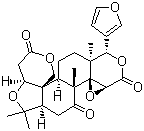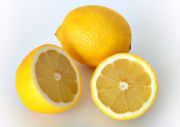LIMONIN
Identification
Ingredient |
Limonin |
Structure:
 |
Synonyms |
limonoate d-ring-lactone; limonoic acid di-delta-lactone |
Molecular Formula |
C26H30O8 |
Molecular Weight |
470.52 |
CAS no. |
1180-71-8 |
Description
Limonin is chemically related to triterpene derivatives found in the Rutaceae and Meliaceae families named limonoids. All naturally occurring citrus limonoids contain a furan ring attached to the D-ring, at C-17, as well as oxygen-containing functional groups at C-3, C-4, C-7, C-16, and C-17. Limonin contains a C-14, 15-epoxide group.
Limonin was studied as an abortifacient agent, amoebicidal substance, chemopreventive agents, and inhibitors of oral carcinogenesis. Therefore limonin may be a valuable chemical for carcinogen treatment or health enhancement.
Scientific experiments
Limonin, nomilin, and nomilinic acid are the predominant limonoids in citrus fruits. These limonoids exist in citrus fruit primarily in the form of glucosides. Unlike the aglycones, the limonoid glucosides (LG) are not bitter. Recent studies in Dr. Miller's laboratory at Baylor College of Dentistry have shown that limonoids and their corresponding glucosides are inhibitors of chemical carcinogenesis. Since the concentration of LG in orange juice and grapefruit juice is 320 and 190 ppm, respectively, the regular consumption of these products exposes the consumer to relatively high concentrations of these anticancer agents. Efforts to increase exposure to LG should increase the potential health benefits. Recently, a company in Japan formulated a test product, designated LG1000, in which the concentration of LG in a mandarin orange juice was increased from 200 to 1,000 ppm.
Antinociceptive and anti-inflammatory effects of limonin isolated from the dried fruits of Evodia rutaecarpa var. bodinieri were investigated. Oral administration of 30 or 100 mg/kg limonin significantly decreased the frequency of licking and biting behavior within a unit of time at the late phase without affecting that of the early phase in the formalin test. Limonin inhibited the rise of vascular permeability induced by acetic acid and the increase of paw edema induced by carrageenin. Limonin also showed inhibitory effects on bradykinin-induced paw edema and arachidonic acid-induced ear swelling. These results suggest that limonin possesses an antinociceptive effect and the effect may be accompanied by an anti-inflammatory action, and that the antinociceptive activity in Evodiae Fructus is partially attributable to limonin.
Availability
Commercial limonin is obtained by extraction from Lemon seed or immature Lemon citrus.

Lemon
Warning:
Above information is only knowledge,not an instruction of usage for this product. The owner of this webiste should not be responsible for any damage because of misuse of the product.
|



